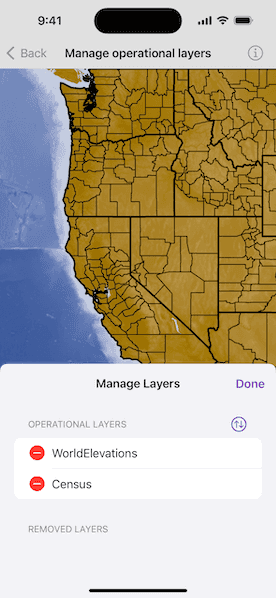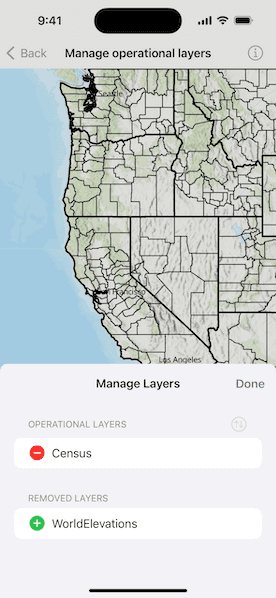Add, remove, and reorder operational layers in a map.


Use case
Operational layers display the primary content of the map and usually provide dynamic content for the user to interact with (as opposed to basemap layers that provide context).
The order of operational layers in a map determines the visual hierarchy of layers in the view. You can bring attention to a specific layer by rendering it above other layers.
How to use the sample
Tap the "Manage Layers" button to display the operational layers that are currently on the map. In the first section, tap the minus button to remove a layer or tap the swap button to change which layer is rendered on top. The map will update automatically.
The second section shows layers that have been removed from the map. Tap the plus button to add a layer back to the map.
How it works
- Get the operational layers from the map's
operationalLayersproperty. - Add a layer using
Map.addOperationalLayer(_:)or remove a layer usingMap.removeOperationalLayer(_:). The last layer in the array will be rendered on top.
Relevant API
- ArcGISMapImageLayer
- Map
Additional information
You cannot add the same layer to the map multiple times or add the same layer to multiple maps. Instead, clone the layer with Layer.clone() to create a new instance.
Tags
add, delete, layer, map, remove
Sample Code
// Copyright 2023 Esri
//
// Licensed under the Apache License, Version 2.0 (the "License");
// you may not use this file except in compliance with the License.
// You may obtain a copy of the License at
//
// https://www.apache.org/licenses/LICENSE-2.0
//
// Unless required by applicable law or agreed to in writing, software
// distributed under the License is distributed on an "AS IS" BASIS,
// WITHOUT WARRANTIES OR CONDITIONS OF ANY KIND, either express or implied.
// See the License for the specific language governing permissions and
// limitations under the License.
import ArcGIS
import SwiftUI
struct ManageOperationalLayersView: View {
/// A map with a topographic basemap centered on western USA.
@State private var map: Map = {
let map = Map(basemapStyle: .arcGISTopographic)
map.initialViewpoint = Viewpoint(
center: Point(x: -133e5, y: 45e5, spatialReference: .webMercator),
scale: 2e7
)
return map
}()
/// The operational layers for the sample.
@State private var operationalLayers: [Layer] = [
ArcGISMapImageLayer(url: .worldElevations),
ArcGISMapImageLayer(url: .censusTiles)
]
/// A Boolean value indicating whether the layers manager is presented.
@State private var layersManagerIsPresented = false
var body: some View {
MapView(map: map)
.task {
// Loads and adds the operational layers to the map.
await operationalLayers.load()
map.addOperationalLayers(operationalLayers)
}
.toolbar {
ToolbarItem(placement: .bottomBar) {
Button("Manage Layers") {
layersManagerIsPresented = true
}
.popover(isPresented: $layersManagerIsPresented) {
LayersManager(map: map, layers: operationalLayers)
.presentationDetents([.fraction(0.4)])
.frame(idealWidth: 320, idealHeight: 260)
}
}
}
}
}
/// A view for managing the layers of a given map.
private struct LayersManager: View {
/// The map to manage.
let map: Map
/// The layers to add to and remove from the map.
let layers: [Layer]
/// The action to dismiss the view.
@Environment(\.dismiss) private var dismiss
/// The layers currently added to the map.
@State private var operationalLayers: [Layer] = []
/// The layers removed from the map.
@State private var removedLayers: [Layer] = []
var body: some View {
NavigationStack {
Form {
Section {
ForEach(operationalLayers, id: \.id) { layer in
HStack {
Button("Remove Layer", systemImage: "minus.circle.fill") {
map.removeOperationalLayer(layer)
withAnimation {
operationalLayers.removeAll(where: { $0.id == layer.id })
removedLayers.append(layer)
}
}
.foregroundStyle(.red)
Text(layer.name)
}
}
} header: {
HStack {
Text("Operational Layers")
Spacer()
Button("Swap Layers", systemImage: "arrow.up.arrow.down.circle") {
let layer = operationalLayers.first!
map.removeOperationalLayer(layer)
map.addOperationalLayer(layer)
withAnimation {
operationalLayers.reverse()
}
}
.disabled(operationalLayers.count < 2)
}
}
Section("Removed Layers") {
ForEach(removedLayers, id: \.id) { layer in
HStack {
Button("Add Layer", systemImage: "plus.circle.fill") {
map.addOperationalLayer(layer)
withAnimation {
removedLayers.removeAll { $0.id == layer.id }
operationalLayers.append(layer)
}
}
.foregroundStyle(.green)
Text(layer.name)
}
}
}
}
.labelStyle(.iconOnly)
.navigationTitle("Manage Layers")
.navigationBarTitleDisplayMode(.inline)
.toolbar {
ToolbarItem(placement: .confirmationAction) {
Button("Done", action: dismiss.callAsFunction)
}
}
}
.onAppear {
operationalLayers = map.operationalLayers
removedLayers = layers.filter { layer in
!operationalLayers.contains { $0.id == layer.id }
}
}
}
}
private extension URL {
/// A world elevations image layer URL.
static var worldElevations: URL {
URL(string: "https://sampleserver5.arcgisonline.com/arcgis/rest/services/Elevation/WorldElevations/MapServer")!
}
/// A census tiled layer URL.
static var censusTiles: URL {
URL(string: "https://sampleserver5.arcgisonline.com/arcgis/rest/services/Census/MapServer")!
}
}
#Preview {
NavigationStack {
ManageOperationalLayersView()
}
}